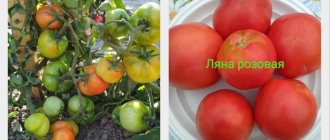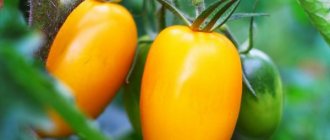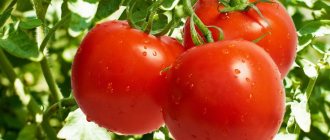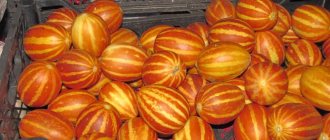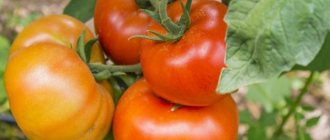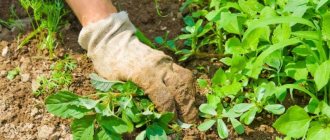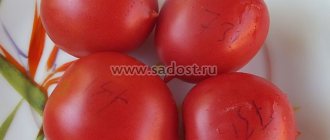| Ripening period: | early |
| Shape, weight of fruits: | Klusha - flat-round, 100 g, Super Klusha - round, 150-250 g |
| Bush type: | determinant |
| Growing regions: | everywhere |
| Productivity per bush: | Klusha - up to 2.5 kg, Super Klusha - up to 3 kg |
Gardeners in risky farming zones especially value tomatoes that can produce crops in open ground. Thanks to agriculture, such varieties appear every year, and are not much inferior to the southern ones. The Klusha tomato and its improved version, Superklusha, are deservedly considered one of the most successful.
Characteristics and description of the Klusha variety
Tomato selection by Dederko V.N., Postnikova T.N. Since 2009 in the State Register.
Designed for open ground, can be grown under film in all regions. Klusha tomatoes are too short for greenhouses. You can place several copies there to get an early harvest, but it doesn’t make sense to plant a lot of tomatoes. Which of these varieties have you grown before?
Broody
16.04%
Superclub
83.96%
Description of the bush
Forms a compact, low-growing plant, reaching 50 cm. The bush is determinate, standard, with thick, strong branches. The seedlings of this tomato variety do not stretch, even when the rest have outgrown.
Dark green leaves of medium size, wrinkled, slightly curved down and cover the fruits. If formation is not carried out, the entire harvest will be hidden inside the bush. This is clearly visible in the photo, and it is thanks to this feature that the variety got its name.
Fruit characteristics
According to reviews from gardeners testing different varieties on the plot, Klusha tomatoes are very similar in description to Demidov tomatoes, only not pink, but red. They are flat-rounded, multi-chambered, green at technical ripeness, the ribs are weakly expressed or absent. The pulp is tasty, medium density, grainy.
The weight of tomatoes on the first fruit clusters is 100 g, the latter become slightly smaller. If you wish, you can grow tomatoes of 150 g or more, but for this you need to shape the plant and standardize the fruits.
The tomato is early, ripens in 90-95 days from the appearance of loops. Per bush yields 1.5-2.5 kg. Suitable for pickling, whole canning, fresh and winter salads.
Klusha tomatoes on video
If you grew Klush tomatoes, please write whether you liked them or not. What was the yield and taste of the fruit? Will you grow them again? How do you rate the disease resistance of this variety? Briefly describe the advantages and disadvantages of this tomato in your opinion. If possible, attach to the comment a photo of the entire bush as a whole or individual fruits that you grew. Thank you!
Your reviews of the Klusha tomato and additions to the description will help many gardeners evaluate this variety more objectively and decide whether it is worth planting or not.
You can see other interesting varieties and hybrids of tomatoes with photos, descriptions and reviews in our Tomato Catalog. Enjoy watching. This is a natural variety of tomato. Therefore, we recommend taking seeds from a ripe fruit and using them for planting in subsequent seasons.
Characteristics and description of the Superklusha tomato
Tomato Superklusha is a relatively new variety, accepted by the State Register in 2015. The authorship belongs to O. V. Postnikova and V. N. Dederko. Designed for open beds throughout Russia, including regions with an unstable climate and cold summers.
The Klusha tomato is considered the original variety; Super Klusha is an improved version, in which the fruits are larger and different in color, the bush is smaller, and the yield is higher.
Description of the bush
Superklusha is a determinate, standard tomato, grows only up to 30-40 cm. The stems are strong and thick. The seedlings do not stretch.
The leaves are green, medium-sized, wrinkled. It’s difficult to see the tomatoes without spreading them apart. The variety is suitable for compact planting.
Fruit characteristics
Super Klusha tomatoes are round, pink, the first ones reach a weight of up to 150-250 g. Their pulp is dense and tasty.
The ripening period is mid-early, 100-105 days pass from the appearance of sprouts to the first colored fruits. Productivity per bush is up to 3 kg.
The Super Klusha tomato variety is universal. It is good in all preparations and when consumed fresh. It transports well and is in high demand on sale.
Bush care
The Klusha tomato does not require pinching, however, high foliage in a dense planting can interfere with the normal distribution of light and provoke the spread of fungal infections. Therefore, if necessary, partial pinching of 2-4 stems and thinning of plantings is encouraged.
Other rules of agricultural technology:
- Balanced watering as the soil dries to a depth of 25-30 cm;
- Loosening the top layer of soil a day after watering;
- Removal of weeds throughout the growing season, but especially during the first 10 days after planting.
- Fertilizing with alternating mineral and organic fertilizers.
Planting dates and cultivation characteristics
According to the characteristics and description, the Klusha variety is early, Superklusha is mid-early. They can be sown for seedlings at the same time, or with a difference of 5-10 days, approximately 50 days before planting in a permanent place.
You need to focus on the climatic features of the region and long-term weather forecast. Approximate dates:
- south – mid-March;
- Ural and Siberia – second ten days of April;
- The middle zone is from the end of March to the first days of April.
Growing seedlings
Before planting, the seeds are heated at a temperature of 53 ° C, pickled and soaked until they swell. Particularly careful gardeners can additionally:
- culling, which makes sense if the seeds are from an unreliable source or are old;
- bubbling;
- stimulation;
- germination or hardening (optional).
Coated or encrusted seeds are planted dry.
It is recommended to choose soil specifically designed for tomato seedlings. This way you won’t have to feed the seedlings before picking.
Individual cups allow you to grow tomatoes without transplanting. 1-2 grains are planted in them. Then you will have to leave a strong sprout, and cut off the weaker ones with nail scissors.
Sowing tomato seeds in common containers:
- Seedling boxes are filled with moist soil.
- Using any convenient tool, make furrows 1-1.5 cm deep at a distance of 4 cm.
- Place the seeds every 2 cm. If there is not enough space, the gap can be reduced to 1 cm.
- Sprinkle with a 1 cm layer of substrate, or level the grooves.
- Water with a spray bottle.
- Cover with glass or film.
Germinate at 22-25° C. The container is ventilated daily and condensation is collected. If necessary, water.
When pecking the seeds, transfer the Superklushi and Klushi seedlings to a room where the temperature is:
- daytime – 14-16° C;
- night – 8-10° C.
After a week, they are placed in comfortable conditions at 25° C. Care of the seedlings is as follows:
- timely watering;
- additional lighting up to 12-14 hours a day;
- protection from drafts;
- daily ventilation.
In the phase of 2-3 true leaves, they are picked into individual containers. With Superclushi, it is recommended not to wait for the third plate to extend.
After about 10 days, the first feeding is carried out. A mineral complex with a predominance of nitrogen is used - it serves as a building material for increasing green mass in plants in the vegetative phase of development.
Superklushi and Klushi seedlings usually do not stretch, which makes life much easier for gardeners.
Transplantation into the ground
It is recommended to harden tomatoes for at least a week before moving them to the garden. But it is better to increase the time to 10-14 days, so that the seedlings grown in warmth take root faster.
First, they are taken out onto the street or balcony in the middle of the day for 20 minutes. The period of stay in the fresh air is gradually increased. For the last 1-2 days, the seedlings should spend the night outside. When the weather worsens, it is covered with non-woven material or film.
Superklusha and Klusha tomatoes are planted in open ground when the ground warms up to 15 ° C. If the weather suddenly worsens, which especially often happens in regions of risky farming, it is better to postpone moving to a permanent place for several days.
For Superklushi, compacted planting is possible - 6 plants per square meter.
Tomatoes are planted by cotyledon or first true leaf. Starting fertilizer and organic matter are added to the holes; on acidic soils - 1-2 tablespoons of lime. Mix additional ingredients with soil and water the tomatoes generously.
It is recommended to immediately mulch with non-woven material, straw, mown grass, and sawdust. It is better not to use humus even if it is completely rotted - it still contains excess nitrogen.
Further care
Tomatoes Superklusha and Klusha are undemanding to care. They are easy to grow for older people who work and visit the site from time to time. The bushes do not need pinching or staking. A decent harvest can be obtained even in an unfavorable year.
The next watering is carried out 10-14 days after transplantation. This will cause the roots of the Klush and Superklush tomatoes to rush down and to the sides in search of moisture. There is nothing to worry about, even if the leaves drop in the middle or end of the day. The signal for watering is the plates that have not returned turgor overnight.
Tomato bush Klusha
For tomatoes, it is recommended to use warm, settled water. But if this is not possible, the main thing is to keep the temperature constant.
It is unacceptable to alternately water the crop with cold water from a well or tap and heated water. Plants may not survive such stress; at best, they will begin to get sick and slow down their development.
Fertilizers must contain the entire mineral complex; only the proportions of the main elements change depending on the phase of development:
- the vegetative stage requires more nitrogen;
- after extending the second flower brush - potassium and phosphorus.
Microelements are given through foliar feeding - this way they are better absorbed. They also provide “first aid” to the culture in case of acute shortage of a particular nutrient.
Growing rules
The tomato variety in question can be grown both in open ground and in a greenhouse. However, without growing seedlings, seeds can be immediately planted in the ground only in the south of Russia. In the rest of our country, the seedling method is more preferable.
Planting seedlings
Sowing of seeds is carried out in March. For seedlings, select a store-bought soil mixture or soil prepared independently. In the latter case, it requires additional disinfection. To do this, the collected soil is calcined in the oven, then taken out into the open air for two weeks. During this period of time, the soil will accumulate oxygen.
Before sowing the seeds, the soil is transferred into the house to adapt to room conditions. At the same time, additional disinfection is carried out. To do this, dilute 1 g of manganese in 2 liters of clean water and mix the solution thoroughly, after which it is evenly poured onto the soil.
Seeds for sowing are first visually inspected, removing all small, diseased and deformed ones. Priority is given to the largest and healthiest specimens. Next, they are placed in a container with saline solution. The seeds that float to the surface of the liquid are collected and discarded, those that fall to the bottom are washed in clean water. After this, the material is disinfected: immersed in a 1% manganese solution for 20 minutes.
Ready seeds need to be germinated. For this purpose, they are evenly laid out between two layers of moistened gauze and left in this position. The cloth should be moistened regularly to prevent the seeds from drying out.
